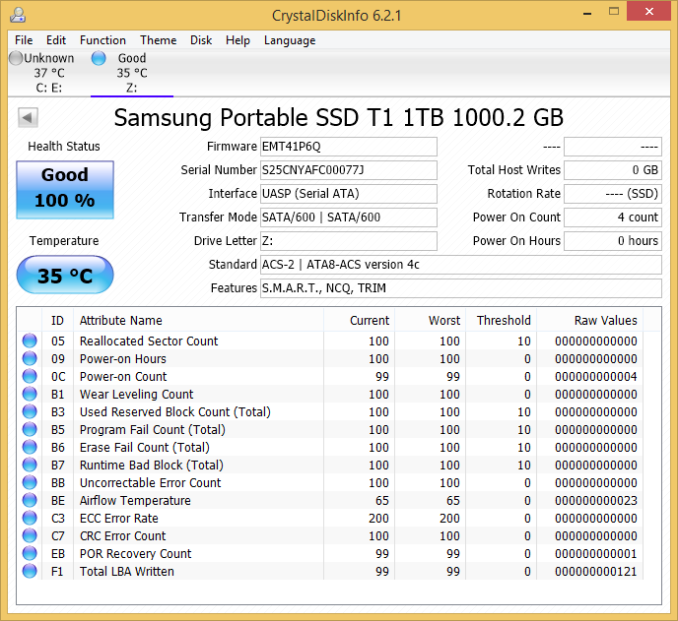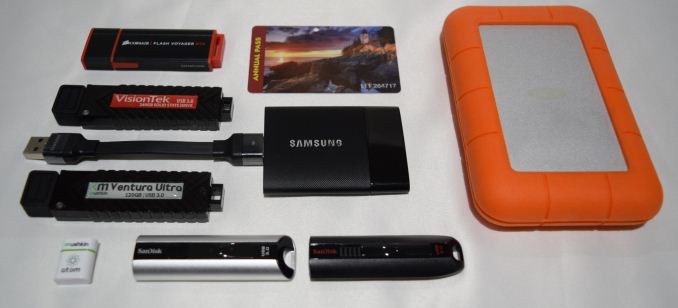Samsung Portable SSD T1 Review
by Ganesh T S on January 20, 2015 10:00 AM EST
Introduction and Testing Methodology
The last few years have seen rapid advancements in flash technology and the rise of USB 3.0 as an ubiquitous high-speed interface on computers. These have led to the appearance of small and affordable direct attached storage units with very high performance for day-to-day data transfer applications. We have already looked at some flash drives with SSD controllers and a USB 3.0 - SATA bridge over the last couple of months. These include the Corsair Flash Voyager GTX 256GB using the Phison S9 controller and the Mushkin Ventura Ultra using the SandForce SF2281 controller respectively.
At CES 2015, Samsung introduced the Portable SSD T1. With the introduction of the T1, Samsung becomes the first tier one manufacturer to enter the external SSD market (if you discount SanDisk's Extreme PRO USB 3.0 flash drives, which, despite being a SSD behind a USB 3.0 - SATA bridge, was never advertised as one). Hardware wise the T1 is based on the 850 EVO, meaning that the T1 uses 32-layer TLC V-NAND and the same full-fledged MEX/MGX SSD controller. CrystalDiskInfo gives us further insight into the unit.
Even though CrystalDiskInfo reports TRIM as a feature, we were unable to get it to work through the bridge configuration. In any case, Samsung also doesn't make any claims about TRIM support. S.M.A.R.T data was not visible to most of the commonly used tools. On the USB 3.0 side, the drive supports UASP (USB-attached SCSI Protocol) that should provide increased performance for sequential transfers. Claimed transfer rates are 450 MBps for sequential accesses and 8K read IOPS / 21K write IOPS. We also have hardware-accelerated AES-256 encryption.
Our review unit was pre-formatted in exFAT. Upon connecting to our testbed, a 128 MB FAT32 partition popped up and provided directions for installing the software / service that allows for the drive to be monitored / utilized with encryption capabilities. After installation, the 128 MB partition disappeared, and the 1 TB volume was made visible. The Samsung SSD program / daemon continues to run in the background and allows for altering the security option (encryption) without reformatting the partition. The gallery below shows the UI of the software running on Windows 8.1 Pro.
Testbed Setup and Testing Methodology
Evaluation of DAS units on Windows is done with the testbed outlined in the table below. For devices with USB 3.0 connections (such as the Samsung Portable SSD T1 that we are considering today), we utilize the USB 3.0 port directly hanging off the PCH.
| AnandTech DAS Testbed Configuration | |
| Motherboard | Asus Z97-PRO Wi-Fi ac ATX |
| CPU | Intel Core i7-4790 |
| Memory | Corsair Vengeance Pro CMY32GX3M4A2133C11 32 GB (4x 8GB) DDR3-2133 @ 11-11-11-27 |
| OS Drive | Seagate 600 Pro 400 GB |
| Optical Drive | Asus BW-16D1HT 16x Blu-ray Write (w/ M-Disc Support) |
| Add-on Card | Asus Thunderbolt EX II |
| Chassis | Corsair Air 540 |
| PSU | Corsair AX760i 760 W |
| OS | Windows 8.1 Pro |
| Thanks to Asus and Corsair for the build components | |
The full details of the reasoning behind choosing the above build components can be found here.
Samsung Portable SSD T1 - Size Comparison (standard credit card size also pictured for a frame of reference)
The list of DAS units used for comparison purposes is provided below.
- Samsung Portable SSD T1 1TB
- Corsair Voyager GTX 256GB
- LaCie Rugged Thunderbolt 500GB
- Mushkin Atom 64GB
- Mushkin Ventura Ultra 120GB
- SanDisk Extreme 64GB
- SanDisk Extreme PRO 128GB
- VisionTek Pocket SSD 240GB


















68 Comments
View All Comments
ArsonW - Tuesday, January 20, 2015 - link
SSDs don't get very hot so this is a non-issue.Laststop311 - Wednesday, January 21, 2015 - link
ssd's only pull like 5 watts at peak and most of the time when in use is around the 3 watt range. Thats very little wattage to produce heat. I don't think overheating is a concern. The test showed no throttling.Laststop311 - Wednesday, January 21, 2015 - link
Also the only reason this ssd went up to 75C is because they hit it with a non stop 15 minutes of heavy writes and reads. The majority of the SSD's usage will not be that heavy so it's not like its going to be running at 75 everytime you use it. Stays at 60 and below for the first 5 minutes of putting it on 100% loadextide - Wednesday, January 21, 2015 - link
75c is nothing. 'Commercial heat grade" which is basically the lowest heat grade goes up to 85c, and industrial grades can be specced as high as 125c.tipoo - Friday, January 30, 2015 - link
I doubt even heavy real world use would see that, as there would be idle times, if even for fractions of a second. This was very much a worst case test, with continuous IO with no breaks which the drive is unlikely to see. Anyways, CPUs can hit 105 degrees Celsius now before their shutoff point I think, 75 doesn't even seem that bad for this, I'll give Sammy the benefit of the doubt and assume the chip was rated high enough that the max temp isn't an issue.Laststop311 - Wednesday, January 21, 2015 - link
so any of those external drives you get, even if they had trim they still will be slower than this samsung. This drive is now king of external usb 3.0 drives. It's the fastest external usb 3.0 drive in any possible scenario. Your voyager gtx will get beat by this drive even on this drives worse day vs voyager gtx's best day.slillo - Thursday, January 22, 2015 - link
Nice write up.Gigaplex - Tuesday, January 20, 2015 - link
"After installation, the 128 MB partition disappeared, and the 1 TB volume was made visible. The Samsung SSD program / daemon continues to run in the background and allows for altering the security option (encryption) without reformatting the partition"Great, a portable drive that doesn't sound like it can be ported to Apple or Linux systems, and may have portability issues between different Windows systems if it's encrypted.
You also mention several times how this drive would be good for Windows To Go. Did you test it? Windows To Go has very strict requirements on what types of drives it will work with. There are only a select few drives on the market that have been validated to work with it.
mczak - Tuesday, January 20, 2015 - link
Well there's a Mac installer. I think if you disable encryption it will work everywhere. Though I guess to run it with linux you'd need to first set it up using either windows or osx, which isn't great (imho would be much better to just ship that as an ordinary drive where you can optionally install whatever magic software...).AJSB - Wednesday, January 21, 2015 - link
I believe ,but i'm not 100% sure, that you can do it with Gparted "Live CD" in a USB Pen.It should find any hidden partitions and delete them or simply create a new partition table that will erase everything.
PS: My personnal experience with HDDs and USB Flash Pens....dunno about SSDs.